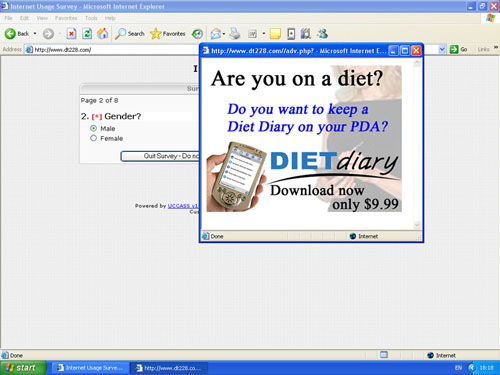Method
Here we shall discuss the methods involved in the research. By following the methods underlined here you may re-create the study.
This study was single-blind – as there was a level of deception involved, in order to test the participants memory recall, without any biases. The study was conducted in a computer laboratory. The independent variable was the users’ experience. The dependent variables, with regards to each hypothesis, were: if they remembered the product being advertised in the pop-up, if they used pop-up blocking software and if their prior experience with pop-ups was positive.
There was a sample size of 70 subjects in total. A convenience sample of undergraduate Irish students participated in this study, participants came from a variety of ethnic and socio-economic backgrounds, and all participants spoke English as a first language. 55.7% of the participants were male and 44.3% were female. Figure 1 describes the raw figures of 39 male participants and 31 female participants.

Figure 1: Gender of participants.
The age range varied from 18 to 60. The mean age for males was 22.17, and the mean age for females was 22.32. The total mean age was 22.24 and the standard deviation was 6.45.
There were two participant groups – the “Experienced” group and the “Inexperienced” group. Subjects were placed in each group based on their answers to the following questions:
1.How long have you been using the Internet for?
2.On a rating of 1 to 5, how skilled are you at using the Internet?
Participants that answered “4 years to 6 years” or “7 years or more” to the first question listed, and answered in the high range of the Likert scale to question 2, were placed in the “Experienced” group. The remaining participants were placed in the “Inexperienced” group.
Figure 2 describe the placement of participants into the two groups. There were 36 participants in the inexperienced group and 34 participants in the experienced group. 51.4% of the participants were grouped into the inexperienced group and the remaining 48.6% were placed in the experienced group. Figure 3 describes the breakdown of male and females in each group. There were 17 males in the inexperienced group and 19 females. There were 22 males in the experienced group and 12 females. The mean age for the inexperienced group was 21 with a standard deviation of 3.65. The mean age of the experienced group was 23.5 with a standard deviation of 8.33.

Figure 2: Number of participants in each group.

Figure 3: Number of males and females in each group.
[ back to top ]
Paper-pencil survey:
The paper-pencil survey consisted of 11 questions. These questions were related to pop-up advertisements. [ view a copy of this survey ] For example:
1. During the online survey a Pop-Up Advertisement appeared. Do you remember seeing this Pop-Up Advertisement?
2. Do you use Pop-Up blocking software? Or a web browser that blocks Pop-Ups?
Consent form:
The consent form indicated to the participant that their data would remain anonymous and that they could remove themselves from the study at any time. [ view a copy of this consent form ]
Online survey:
The online survey was created by a web developer/designer under the supervision of the researcher. An industrial strength survey software called UCCASSv1.8.1. was used. The online survey consisted of 8 questions. These questions were related to “Internet Usage” and key demographic information. [ view a copy of these questions ] [ view the online survey webpage ] For example:
1. How often do you use the Internet?
2. On a rating of 1 to 5, how skilled are you at using the Internet?

Figure 4.1: A screen-shot of the online survey.

Figure 4.2: A screen-shot of the online survey with the pop-up advertisement.
A pop-up advertisement:

Figure 5: The pop-up advertisement.
The pop-up advertisement was advertising a fictional product – a piece of software for a mobile computing device. Two main images were used – a PDA and a faded image of a woman in the background. 4 main bodies of text were used - “Are you on a diet”, “Do you want to keep a Diet Diary on your PDA?”, “Diet Diary”, “Download now, only $9.99”.
[ back to top ]
Pilot Study:
A pilot study was conducted with 10 participants of varied age and experience, both male and female. Conclusions from the pilot study were that the questionnaires did not require any changes, the pop-up was a realistic interpretation of a real pop-up advertisement, and that the online survey worked adequately.
The Study:
As the participants were to complete an online survey, the settings were altered on each computer each participant was to use. As a precaution any pop-up blocking software was disabled completely and the Internet cache was emptied.
Participants completed the online survey which focused firstly on their demographics and secondly on their Internet experience and frequency of use. During this survey a pop-up window displaying an advertisement appeared - 20 seconds into the online survey.
After the survey was completed the participants completed a pencil paper test – with questions relating to the pop-up advertisement that appeared, questions on their attitudes/experience of pop-ups and questions related to pop-up blocking software.
After completing both surveys the participants were debriefed.
[ back to top ]
webdesign by s.cochrane ©2006